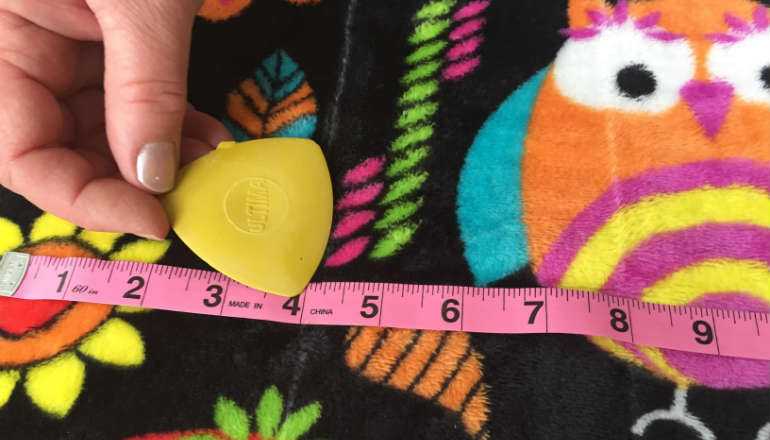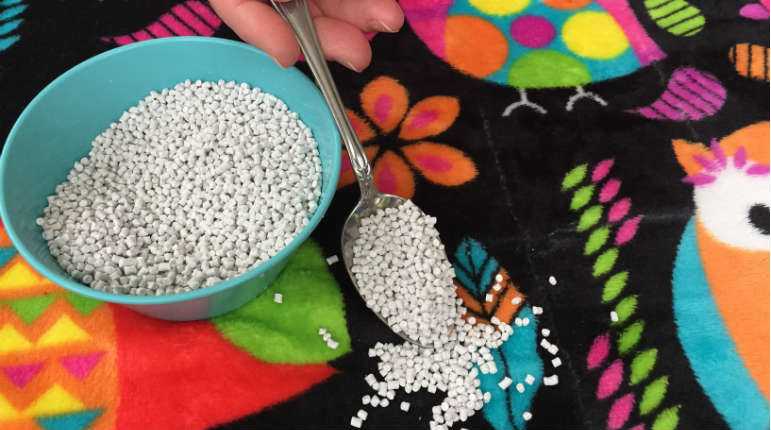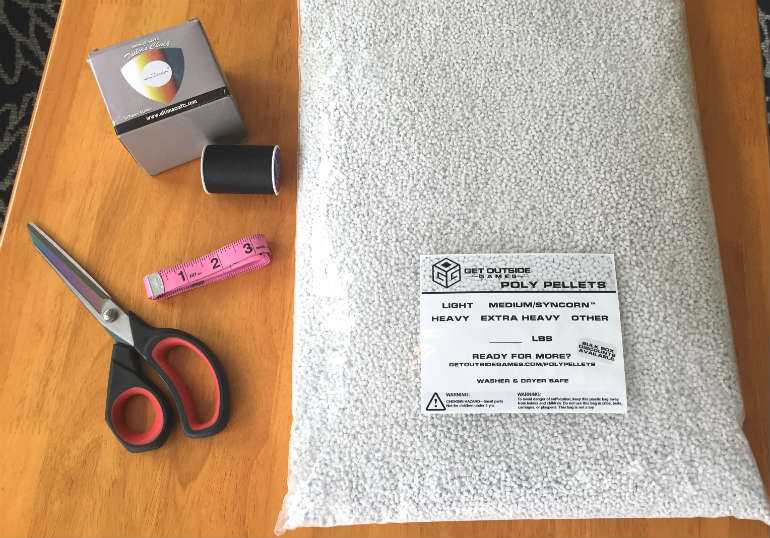How to Make a DIY Weighted Blanket: Step by Step Instructions

Weighted blankets have taken the country by storm, surging in popularity over the past year. With benefits ranging from better sleep to lower blood pressure, the calming effects that weighted blankets offer are keeping its popularity high and dominating retail sales.
Although extremely effective, weighted blankets can also be extremely expensive, ranging from $100 to $400 in price.
| Recommended Weighted Blankets | Our Rating | ||
|---|---|---|---|
| Baloo Weighted Blanket | Best Overall | Check price | |
| LUXOME Weighted Blanket | Best Premium | Check price | |
| BABO Cooling Weighted Blanket | Best Cooling | Check price | |
| Gravity Blankets | TIME Magazine’s Best Inventions of 2018 | Check price |
Do-It-Yourself weighted blankets are a great way for families to take advantage of the sensory benefits these blankets offer at a fraction of the price.
In this article, we will present a step-by-step guide for making a weighted blanket, but first let’s take a look at why making your own can be worth the time and money invested.
Why DIY?
Weighted blankets can be great tools for managing insomnia, anxiety, autism and ADHD, PTSD, and Restless Leg Syndrome.
Making your own weighted blanket DIY helps not just getting to know the product better but you can make sure you use the best materials available, and all this on a budget.
What are Weighted Blankets?
Weighted blankets are exactly what their name suggests - blankets that are weighted. Good weighted blankets have tiny, weighted objects sewn into the lining that evenly distributes weight throughout the blanket.
Weighted blanket fillers most commonly include glass beads and steel shot beads. Some other options include rice, beans, or even dried past. To keep the weight evenly distributed throughout the blanket, the filler is stitched into pockets throughout the blanket.
How to Make a Weighted Blanket - DIY Style?
How to make a weighted blanket is not rocket science and requires no special skills, so everyone with the right materials and a bit of time can make their own diy blanket following the steps described below.
If a weighted blanket is the right option for helping to treat insomnia related to any of the above mentioned issues, then the next step is determining what type of materials are needed and how big the blanket needs to be.
First of all, consider the individual who will be using the blanket and plan the measurements accordingly as we described in our guide on how to choose a weighted blanket.
We do not recommend making a blanket to fit a bed. For instance, if an 8 year-old child with autism needs a weighted blanket to sleep in a twin sized bed at night, a twin size weighted blanket is not necessary - it only needs to fit the person.
A good rule of thumb when measuring for a blanket is “chin to heel.” Having excess blanket hang off the sides of the bed is not only a waste of materials, but it can also tug weight away from the body and be difficult to adjust during the night, especially for children.
For insomnia, the best blanket size is generally chin to heel also. This ensures that the pressure from the weighted blanket hits all of the body’s Deep Touch Pressure points without covering the face.
For other symptoms, such as ADHD or Restless Leg Syndrome, the blanket may only need to cover the top part or the lower part of the body. For these smaller blankets, measure the length from chin to heel and divide by two. This will make a nice half-size blanket for the individual who just needs to drape it over the shoulders or over the legs on occasion.
Weight Guidelines
After determining the length, the next step is determining what weight is needed. A good rule of thumb for calculating the right weight is 10% of body weight plus one or two pounds.
Here you can find a weighted blanket weight chart to pick the right weight based on the body weight.
It is important to emphasize that this is just a guideline and the weights effectiveness will depend on the unique needs of an individual. After all, the goal of a weighted blanket is to encourage calming comfort and if a person is not comfortable, then the blanket will be counterproductive.
Think about how an individual typically responds to pressure, not just touch. If someone finds compression clothing soothing or often hugs the body with the arms to self-soothe in overstimulating situations, then 10% of the body weight plus one or two pounds may be a good place to start.
Selecting Weighted Blanket Materials

There are a plethora of materials that can make quality weighted blankets. Any craft or fabric store will have a good variety of products to look through when choosing the best fabric and filler for a new blanket.
If an individual prefers sleeping in a cooler environment because they are easily overheated, a warm, flannel material is probably not the best option. As always, a DIY project is the perfect opportunity to tailor a product to individual need and preference.
Check out our guide about the best cooling blankets to get some inspiration on the materials to use for all-season joy.
Plastic Poly Pellets and Other Fillers
When selecting the right filler, there are a few options to consider.
First, consider weight per unit and price per unit. Organic material such as rice or beans will be extremely inexpensive, but it will also be significantly lighter, meaning more volume is necessary to reach a desired weight.
Also, consider durability. Some fillers, such as beans, rice, or grains will be cheap, but will not last as long. These items will expand if they come into contact with water. They can lose their shape, mildew, and attract insects.
For durability, consider purchasing steel or glass beads, which are washable and will last indefinitely.
How to Sew a Weighted Blanket
Once the size, weight, and materials have been determined, it is time to start making the weighted blanket. Before getting started, remember to wash and dry the fabric before measuring or cutting it.
Not only will it need to be clean, but if it is a material that will draw up after washing and drying, an accurate measurement can not be taken before laundering.
Step by Step Instructions For Creating your Own DIY Weighted Blanket

Step 1: Gather the Materials
You will need:
- Fabric
- Poly pellets or other filler
- Scissors
- Tailor’s chalk
- Measuring tape
- Kitchen scales, measuring cups, or tablespoons
- Sewing machine
For our blanket, we chose plastic poly pellets known for their durability and affordability. A 14-pound bag is available at Amazon or other online stores.
We are making a 13-pound blanket for a 130-pound adult, so we purchased a 14-pound bag. We recommend buying at least one extra pound of filler since making weighted blankets can be messy and it is inevitable that some of the filler will get spilled and lost during the process.
Step 2: Measure the Fabric
The length of our blanket will need to be 58 inches long to cover the individual from chin to heel. It will also need to be 26 inches wide to comfortably cover the body.
There needs to be a one inch margin all around the fabric to allow for binding. We purchased 5 yards of this fun Heavenly Plush Owl fleece, so there will be plenty of material for this blanket. Cut two pieces of fabric with the right dimensions and stack them on top of each other.
Step 3: Make a Grid with Chalk
Using tailor’s chalk and measuring tape, we are going to mark columns down the length of the blanket every four inches (after allowing for the one-inch margin).
Then, mark horizontal rows every four inches across the vertical rows (still allowing for the one-inch margin). Once you have finished marking the rows, you should have a grid of four-inch squares marked across the entirety of the fabric. These will be the pockets that will hold the pellets.
Step 4: Start Stitching
Once the grid has been marked off, stitch the two sides and the bottom of the blanket closed. Then, start sewing along the vertical lines marked along the length of the blanket.
Once three sides and all of the vertical columns have been stitched shut, there should be long rows of open pockets. Now it’s time to start filling.
Step 5: Fill the Blanket with Weight
Filling the blanket so that the weight is evenly distributed throughout may be the most tricky part. It is time to put those fourth grade math skills to work! For our blanket, we knew we would end up with 2 four-inch squares. We also knew we needed a 13-pound blanket.
So, we divided the number of squares by the number of pounds we needed to distribute. That came to roughly 10.4 ounces per square.
Kitchen scales are a great way to accurately measure out the right amount of filler, but if one is not available, just convert pounds into ounces and measure with a spoon or measuring cup.
Remember, 16 ounces = one pound. To determine how many ounces you will need per square, multiply the number of pounds by 16 (13x16=208) and divide that number by the number of squares (208+20=10.4).
Once the filler has been spooned into the rows, make sure it falls all the way to the bottom of the blanket.
Then, stitch across the blanket horizontally on that first horizontal row of the grid. This will close off the first row of squares, keeping the pellets secure and evenly distributed.
Repeat this step until all of the rows have been sewn shut and the blanket consists of several neat squares throughout.
That’s it, your DIY weighted blanket is DONE!
How to Make a Washable Weighted Blanket?
The question of cleaning will inevitably arise at some point. Many weighted blankets are washer- and dryer-safe, but it all depends on the type of filler that is used in the blanket and how heavy the blanket is.
Remember, food fillers such as rice, beans, or grains will not fare well in water. Moisture can cause them to swell, clump together, and mildew. Glass beads and plastic pellets, however are safe to wash and even dry.
Depending on the size of the blanket, though, it may be best to take it to a laundromat where the machines are designed for more heavy-duty loads.
As a rule of thumb, do not put a blanket heavier than 20 pounds in a household washing machine.
When possible, just spot clean the blanket to remove stains and allow it to air dry. The entire blanket will need to be cleaned at least four times a year (more if it is used more than a few times a week).
Also, consider airing it out on nice, sunny days. The sun’s UV rays are a natural germ-killers, plus the blanket will stay fresh without losing its shape.
You can read our detailed Maintenance and Washing Guide for Weighted Blankets here.
Other Considerations for your Handmade Weighted Blanket
While weighted blankets are great for all kinds of ailments, especially insomnia, they are not safe for babies. Never use a weighted blanket on a child that is under the age of 2.
If swaddling and cuddling helps a fussy baby get to sleep, some parents or caregivers may be tempted to try a small weighted blanket to comfort them. This can be very dangerous as babies’ bodies are not developed enough to withstand pressure for long periods of time, not to mention the risk of suffocation.
Also, remember that weighted blankets work best when they are designed for an individual. This means that it probably will not be effective to share weighted blankets with family and friends unless they are extremely close in size.
A 15-pound weighted blanket will not be well-suited to every member of the family. An individual’s size and weight will determine the type of weighted blanket that is effective.
Conclusion
Hopefully the question of how to make a weighted blanket has been answered and now shows that it is actually not that difficult to do at all.
In this Pinterest age of DIY projects, making a diy weighted blanket can be a great way to experience the many benefits of Deep Touch Pressure without breaking the bank. Shop around and make educated decisions about the right filler and fabric. Find the best materials that suit your needs, then wrap up in that new weighted blanket and enjoy!
